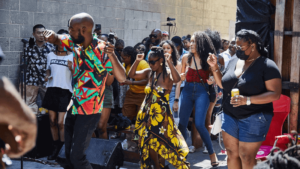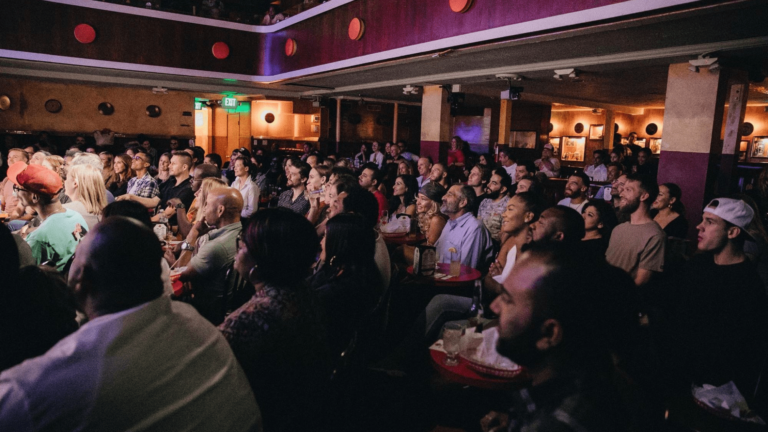Effective marketing gets the right message to the right audience.
Want an easy but overlooked way to make your event promotions more relevant to your audience? Segment your audience into different groups. In fact, relevant ads create positive brand associations 35% more often.
You can segment your audience based on shared traits, like location or interests. That helps you focus your efforts where they’ll make the biggest impact and even create customised marketing campaigns to appeal to different interests.
Read on to learn how to create your own audience segments and use them to improve your outreach dramatically. Some of Eventbrite’s organisers are experts at targeting and marketing to their audience segments, and we’ve worked with thousands of organisers globally, so we’ve looked at their strategies and broken them down to help you.
Tips for audience segmentation
1. Remarket to interested prospects
5. Create targeted deals and discounts
6. Marketing channel audience segmentation strategies
What is audience segmentation?
Audience segmentation divides people into groups based on what they like or do, so your marketing outreach matches their interests better. It’s a way of creating more accurate, targeted marketing messages.
There are all kinds of segmentation that we’ll get into later. But, generally, those fall into categories like behavioural segmentation (people who have done something like attended a past event) and demographic segmentation (your audience’s ages.)
How do you segment your audience on Eventbrite?
Because Eventbrite tracks key information about people who attended your past events, it’s easy to segment your audience on the platform. Here’s a quick guide on how:
Begin with data about your past and potential attendees. Set up marketing pixels to collect data from your website and use past data to identify how many attendees have come to multiple events.
[easy-tweet tweet=”How #eventprofs can use segmentation to boost their marketing performance” user=”eventbrite” usehashtags=”no”]
Analyse this data and identify the segments that are most valuable to you. These may be VIP ticket buyers, repeat attendees, or attendees in your sponsors’ target audience. Then, create custom lists for each segment in your CRM or email marketing system.
Ready to start personalising your event marketing?

Types of audience segmentation: Examples and strategies
To get started, here’s a list of important audience segments for event creators. How you segment your audience could depend on what kinds of events you plan on organising. Here are some ideas for segmenting your audience, with examples of successful creators who could segment their audience that way.
Interest-based segmentation
Interest-based segmentation sorts your audience based on their hobbies and preferences. This method is particularly effective for Cotesbach Educational Trust, allowing them to tailor their marketing to align perfectly with the varied interests of their audience. For example, they might identify one segment of their audience that’s passionate about cooking. Events like Cotesbach’s Autumn Wild Foraging and Cooking Workshop would fit this group well.
But other people going to their events might not be interested in just cooking the food but also creating things from nature themselves. Cotesbach’s Foraging and Nature Crafts workshop might be better for that audience. They can identify those segments by looking at which kinds of events their past attendees have gone to, not just grouping their past attendees into one category.
Industry-based segmentation
Industry-based segmentation involves categorising your audience by their professional field or industry interest. This method is particularly effective for organisations like the TechEx, which can tailor their events and marketing content to meet the interests of professionals in the different fields they appeal to.
For example, their event on AI and Big Data for developers might look like it has just one larger audience to target. However, developers have different aspects of AI that might interest them. Marketing the event to each group would be more effective if the organisers segmented each of them and created separate materials for each.
Segmentation from event page views
Segmenting based on event page views involves categorising your audience based on their interactions with your event page. This strategy is particularly effective for organisations like STAA that host frequent events and can benefit from retargeting visitors.
Using marketing pixels installed on their event pages allows STAA to track who visits their pages and how they interact with the content. This data would allow them to retarget those visitors with personalised ads and emails, reminding them to complete their registration or offering them similar upcoming events.
For organisers with a busy event calendar, this approach ensures that interested individuals re-engage, increasing the likelihood of converting page views into actual event attendance. That’s why 77% of business-to-business of business-to-business sales and marketing professionals believe personalization leads to better sales and growth.
Past attendance
Segmenting your audience based on past attendance is a powerful audience segmentation strategy for organisers like Sheffield Action on Plastic with annual or repeating events. This method would let them identify attendees who have shown a previous interest in their events and might be inclined to participate again.
By analysing past attendance records, Cliff Top Music Festival could tailor their communication and promotions, offering early bird tickets, exclusive access, or personalised updates about what’s new or different next year. This targeted approach creates a sense of loyalty among past attendees, increasing their chances of returning, as they feel recognized and valued by the creator.
Geographic segmentation
Geographic segmentation involves dividing your audience based on where they live or where they’re from. This would be especially useful for event organisers like Pitcher & Piano at their Nottingham location, as they could tailor their events and marketing efforts to local audiences and showcase its unique building – a cathedral!
Frequency of attendance
Segmenting your audience based on the frequency of attendance helps identify your most loyal or engaged attendees. This approach can be especially effective for organisations like Candlelight Concerts, which hosts various performances and events throughout the year.
By tracking the number of tickets purchased or the total amount spent by each attendee, the concert hall can identify their most frequent visitors. This information allows them to offer special promotions, early ticket access, or exclusive perks to these high-value attendees to reward their loyalty and encourage future attendance.
Tailoring communication and offers based on attendance frequency helps build a stronger relationship with the audience, ensuring they feel valued and more likely to continue supporting the venue.
Registered attendees
Focusing on registered attendees allows event organisers to communicate directly with those who have already shown interest in their events. For organisers like Bearfoot Comedy, leveraging registered attendees’ information for upcoming events could be a powerful tool.
This segment includes individuals who have signed up for an upcoming show but haven’t necessarily attended in the past. That’s a unique opportunity to engage, inform, and excite them in the lead-up to the next show.
Through targeted emails, social media updates, or exclusive previews, you can enhance the experience for registered attendees, increase anticipation, and even encourage word-of-mouth promotion. Engaging registered attendees can increase satisfaction rates and build a loyal community around your brand.
1. Remarket to interested prospects
It’s always easier to sell tickets to people who are already interested. That’s what makes retargeting — targeting people who have already expressed interest — such an effective audience segmentation strategy. Here are a few ways to achieve that:
Event page visitor remarketing
This strategy uses the marketing pixel method described earlier: Use marketing pixels on your website to track who visited an event page. Then, create retargeting ad campaigns to reach the people who didn’t purchase a ticket.
Past attendee retargeting
You can also send marketing emails to people who have attended similar events you’ve hosted. Remarketing yields strong results because these audience segments have already expressed interest in your event.
VIP retargeting
VIP attendees are your event’s most valuable participants, often including industry influencers, repeat attendees, or big spenders. Retargeting this group requires a more personalised approach, such as exclusive offers, early-bird registration, or behind-the-scenes content. By making VIPs feel recognized and valued, you’re not just encouraging them to attend again; you’re turning them into advocates for your event.
Retargeting past no-shows
Sometimes, people register for an event but don’t attend. While this can be disappointing, it also presents a unique opportunity. These individuals were interested enough to sign up, so retargeting them with surveys to understand why they didn’t attend, followed by customised messaging addressing these concerns, can help recapture their interest for future events.
Retargeting people who expressed interest but didn’t register
Like event page visitors, this group includes people who engaged with your social media content or clicked on an ad but didn’t complete the registration process. Retargeting them with ads highlighting what they’re missing out on or offering a limited-time discount can motivate them to leap from interested observers to registered attendees.
Retargeting people with a recommendation for a purchase multiple times can increase the odds they actually buy it.
Additional retargeting strategies
Beyond these methods, consider retargeting in an even more narrow way based on behaviour or engagement level. For example, you could target people who spend a significant amount of time on your registration page but don’t sign up.
Target this audience with ads that answer common questions or concerns about the event. Similarly, entice those who have engaged with your event on social media but haven’t visited your website with a direct link to the registration page in a personalised ad.
2. Build loyalty programs
Keep your best customers invested in your brand with special perks. Send exclusive offers, early access, or VIP upgrades to your frequent attendees. This will build loyalty and generate pre-event buzz across social media.
The benefits of developing loyalty programs are significant. This is because repeat customers will spend more with your brand, leading to a better Lifetime Value (LTV).
You should calculate your LTV to CAC ratio to learn what you’re getting from the money you spend on acquiring each customer. In general, a good ratio is 3:1, about three dollars of LTV for every dollar spent on acquiring customers.
To effectively track loyalty and identify repeat attendees, use event management platforms like Eventbrite, which offer tools to segment your audience based on their attendance history. By integrating Eventbrite with your CRM system, you can create detailed profiles for your attendees, noting how often they attend your events, their spending patterns, and their preferences.
This data is invaluable for tailoring audience segmentation analysis. That lets you improve your loyalty programs and make sure your rewards genuinely appeal to your most loyal customers.
Eventbrite also rewards you for high repeat attendance by showing potential attendees your repeat attendance rate at your next event. Events with high percentages of repeat attendees are likely to deliver a great attendee experience, which serves as a testament to the event’s quality but also acts as a powerful marketing tool.
On Eventbrite’s platform, you can implement loyalty programs by using features like promo codes for discounts or early access for your upcoming events, exclusive to repeat attendees. You can also create custom email campaigns targeting this segment with special offers.
Just navigate to your Event Dashboard, select Add Tickets,’ and then ‘Promo Codes’ to create an offer right there.
By thoughtfully implementing loyalty programs and utilising the tools available on platforms like Eventbrite, you can inspire attendee loyalty, increase repeat attendance rates, and ultimately, build a strong, engaged community around your event brand.
This not only improves the overall event experience for attendees but also contributes to the long-term success and sustainability of your events.
3. Send event updates
Audience segments can also improve your communication strategy during your event. You can filter your list of registered attendees to send targeted messages. For example, sort by interest to promote a speaker or workshop or give VIP attendees special access to sponsor perks. This segmentation leads to better customer service and a better event experience.
The first step in creating segmented updates is to create separate lists of the people you want to send your targeted updates. You can put those together in a spreadsheet or do it directly in Eventbrite by going to the marketing tab, selecting email campaigns, and creating a new campaign.
Next, you’ll see several options to create an email list from a spreadsheet, your list of past attendees, or do it manually in the platform. It’s fast and easily customisable — perfect for highly targeted campaigns. After that, you just hit ‘continue’ to write the email you want to send!
Tailoring messages for different segments
Now that you know the logistics of targeting your communications, let’s go through some audience segmentation examples and how each segment might appreciate different communication.
- VIP attendees: For VIPs, who might expect a higher level of service, consider sending updates that include exclusive offers, private meet-and-greets, or early access to event materials. Personalization is key here, as VIPs should feel recognised and valued.
- Attendees from far away: Those travelling from distant locations may appreciate receiving information about accommodations, transportation options, and local attractions. Consider including tips on making the most of their visit, which not only aids in their planning but also demonstrates attentiveness to their needs.
- Interest-based segments: Tailor communications based on attendees’ interests by promoting specific workshops, speakers, or activities at your event that align with their preferences. This ensures attendees know the parts of your event that will most appeal to them, increasing their likelihood of participation.
4. Customise your content
Work toward long-term success with event marketing built around key audience segments. Identify the most valuable groups to your events and create content specifically relevant to them.
Once you’ve produced this targeted content, you can reach the right audience by using social media targeting options. For example, if you write an article about why CEOs should attend your latest conference, you can promote that post to reach people with ‘CEO’ in their job titles on Facebook or LinkedIn.
Understanding and segmenting your audience is a crucial first step to promote your event.
Then, you can create specialised content for them with the hub-and-spoke model. The model is a content marketing strategy that involves creating a central piece of content (the hub) that addresses a broad topic of interest to your target audience.
From this hub, you create smaller, more specific pieces of content (the spokes) tailored to the interests and needs of different audience segments. This approach allows for a wide-reaching yet targeted content marketing strategy, efficiently utilising resources while ensuring content relevance across various groups.
Why it works well for targeting different audiences:
- Precision targeting: By breaking down the main topic into specific interests, you can directly address each segment’s particular concerns or needs, increasing engagement and relevance.
- Efficient use of content: The hub piece serves as a comprehensive overview, while the spokes delve into details for those interested in more. This creates multiple entry points for engagement, optimising your content’s reach.
- Flexibility: The model allows for easy adaptation as your audience grows or shifts, letting you add new spokes to the hub as new trends emerge or interests change.
Types of events that benefit the most:
- Long-term or ongoing events: Events that occur regularly or over an extended period can significantly benefit from content marketing, as it supports sustained engagement and interest through continuous content creation and distribution.
- Conferences and workshops: These events often cover broad topics with various subtopics, making them ideal for the hub-and-spoke model. Content can be designed to appeal to different professional groups, skill levels, or areas of interest.
- Cultural and educational series: Events focused on cultural enrichment or educational content can use this model to target different demographics or interest groups with tailored content that appeals to their specific preferences or learning goals.
Employing the hub-and-spoke model allows you to create a content marketing strategy that attracts a wide audience and deeply engages each segment. That’ll help you get higher attendance and participation rates.
5. Create targeted deals and discounts
Creating targeted deals and discounts makes your events more appealing, driving attendance and revenue. By offering special promotions to specific audience segments, you can fill seats more efficiently and build goodwill and loyalty among your target attendees. This method is especially powerful when combined with your other audience segmentation strategies, allowing for highly personalised marketing efforts that resonate with potential attendees.
Benefits of targeted deals and discounts
When you target your deals along audience segments, you get benefits in three main categories:
1. Conversion rates
Tailored discounts can serve as a strong incentive for people interested but hesitant. By addressing different segments’ specific needs or preferences, you’re more likely to convert interest into action.
2. Revenue growth
While offering discounts may seem counterintuitive to increasing revenue, targeted deals can lead to more ticket sales, including upsells and repeat business. For example, discounting first-time attendees can turn them into loyal patrons who attend future events at full price.
3. Customer satisfaction
Providing deals that cater to the unique desires of your audience segments shows that you understand and value them, which can enhance their overall event experience and satisfaction.
Let’s clarify this by looking at how event organiser Collin Davry creates events targeted to locals and visitors alike, like the Kentish Town – a Walk through a History Emporium. This guided tour offers an enjoyable and informative way for both locals and visitors to learn about the area’s history.
This approach encourages local community participation and builds local goodwill. It also helps them build even more satisfaction with attendees as they form a strong, local community bound together by these events.
How to target your deals with Eventbrite
Eventbrite’s look-alike-audiences feature in paid social media ads is a valuable tool for getting the most impact out of your event promotions. This feature lets you target new potential attendees who share characteristics with those who have previously purchased tickets.
This tool is especially powerful if you’re new to event marketing. In the words of Eventbrite’s Amanda Crawford, “While experienced marketing experts may consider it basic, for novice creators getting started with our marketing tools, it’s a more nuanced feature that can unlock a lot of value!”
6. Marketing channel audience segmentation strategies
Marketing channel audience segmentation is another important strategy in tailoring your promotional efforts to your audience. In this case, you must look into the specific demographics that use various social media platforms. Each platform has its unique audience age breakdown, for example, which can significantly influence your marketing campaigns’ style, tone, and content.
For more detailed information, you should look into how to use social media for events specifically. However, in general, platforms like TikTok and Instagram tend to attract teenagers to young adults in their 20s. This demographic might be more receptive to vibrant, fast-paced content that leverages the latest trends, memes, and music.
On the other hand, platforms like Facebook and LinkedIn attract a broader age range, including a significant portion of users in their 30s, 40s, and older. These audiences may prefer more informative, detailed, and professionally-oriented content.
The perfect platform for audience segmentation analysis
Audience segmentation makes your marketing efforts more impactful, helping you drive higher attendance without too much extra work. Whether you’re just giving a personal touch to your VIPs or creating separate versions of your newsletter for different parts of your audience, you need the right platform to do that segmentation with.
That’s why so many event organisers work with Eventbrite. It makes it easy to identify, save, and target audience segments when you market your events. Eventbrite’s suite of marketing tools is built for effective audience segmentation and outreach.






